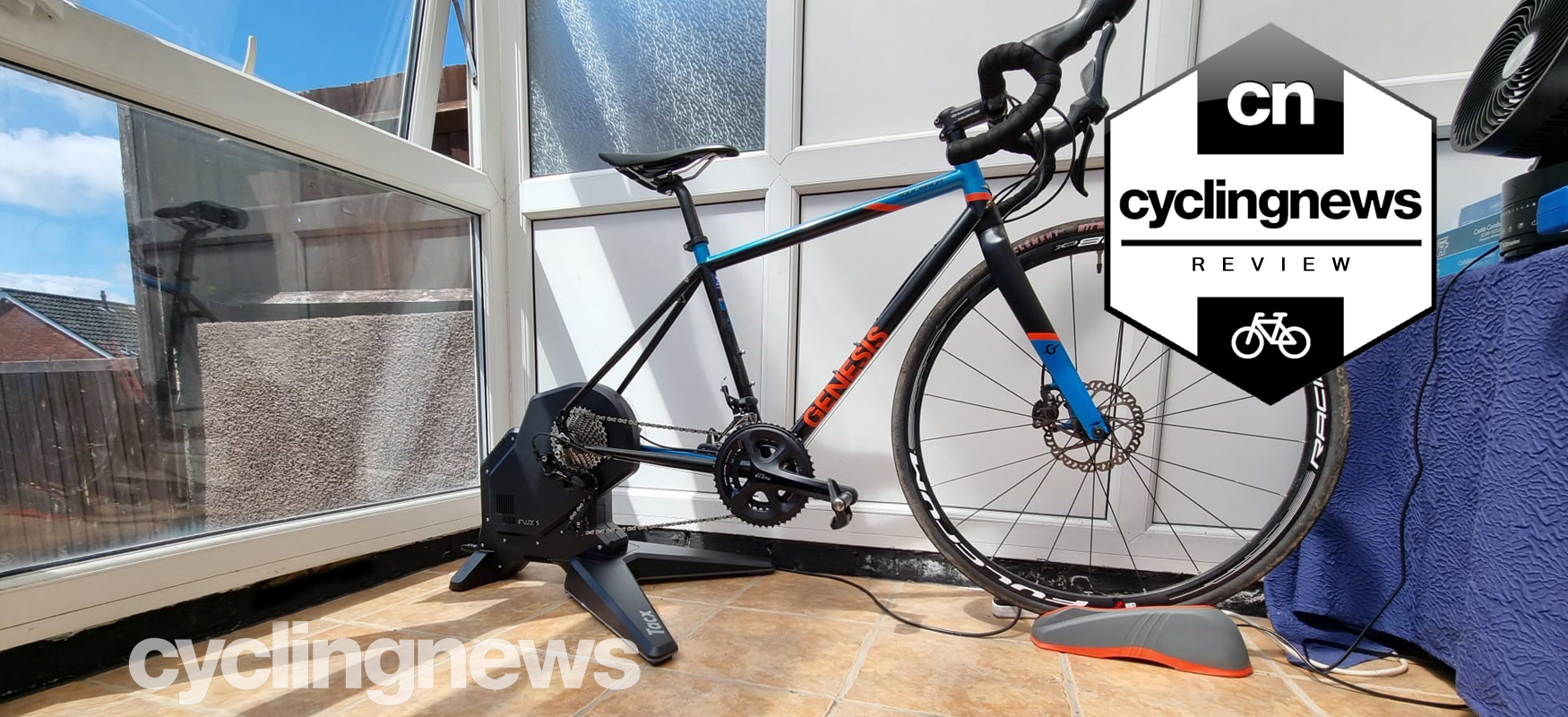Cyclingnews Verdict
The Tacx Flux S is a powerful, affordable and sturdy smart trainer that's great as long as you can dedicate a permanent space for it in your home
Pros
- +
Super sturdy and stable
- +
Widely compatible with different bike types
- +
Heavy 7kg flywheel offers a realistic ride feel
- +
Super smooth electronic resistance
- +
Easy to assemble
- +
Great value for money
Cons
- -
Extremely heavy and no carry-handle
- -
No folding parts for easy storage
- -
Slight overlapping with IS post mount adapters
You can trust Cyclingnews
In the turbo trainer market, there are several big names that come to mind, and Tacx is certainly one of them. Acquired by Garmin in 2019, the brand is known for its wide range of indoor trainers that includes everything from its entry-level Antares rollers to the premium Neo Smart Bike with all its bells and whistles.
The Tacx Flux S sits in the middle of Tacx's range of smart trainers as the most affordable direct-drive smart trainer below the Flux 2 and the Neo 2T. Costing less than half the price of the latter, the Flux S represents the brand’s answer to making indoor smart trainers as affordable and accessible as possible. With its price being its key USP — particularly in comparison to the next-level Flux 2 — the Flux S is aimed at those who are taking their indoor cycling to the next level without needing to go full-pelt, and it significantly undercuts many of its competitors like the Elite Suito and Wahoo Kickr Core. That said, it does have some serious competition in the form of Elite’s Zumo, which is not only cheaper but is also compatible with 142x12mm thru-axles.
But does ‘affordable’ mean cheap and therefore a bad choice in the long-term, or does it offer enough value for money to be competitive among the best smart trainers?
If you’re just getting started with indoor cycling, or you’re upgrading from a dumb trainer, is the Flux S worth your hard-earned cash? Having spent the last six months training with one, here’s what we think.
Design and aesthetics
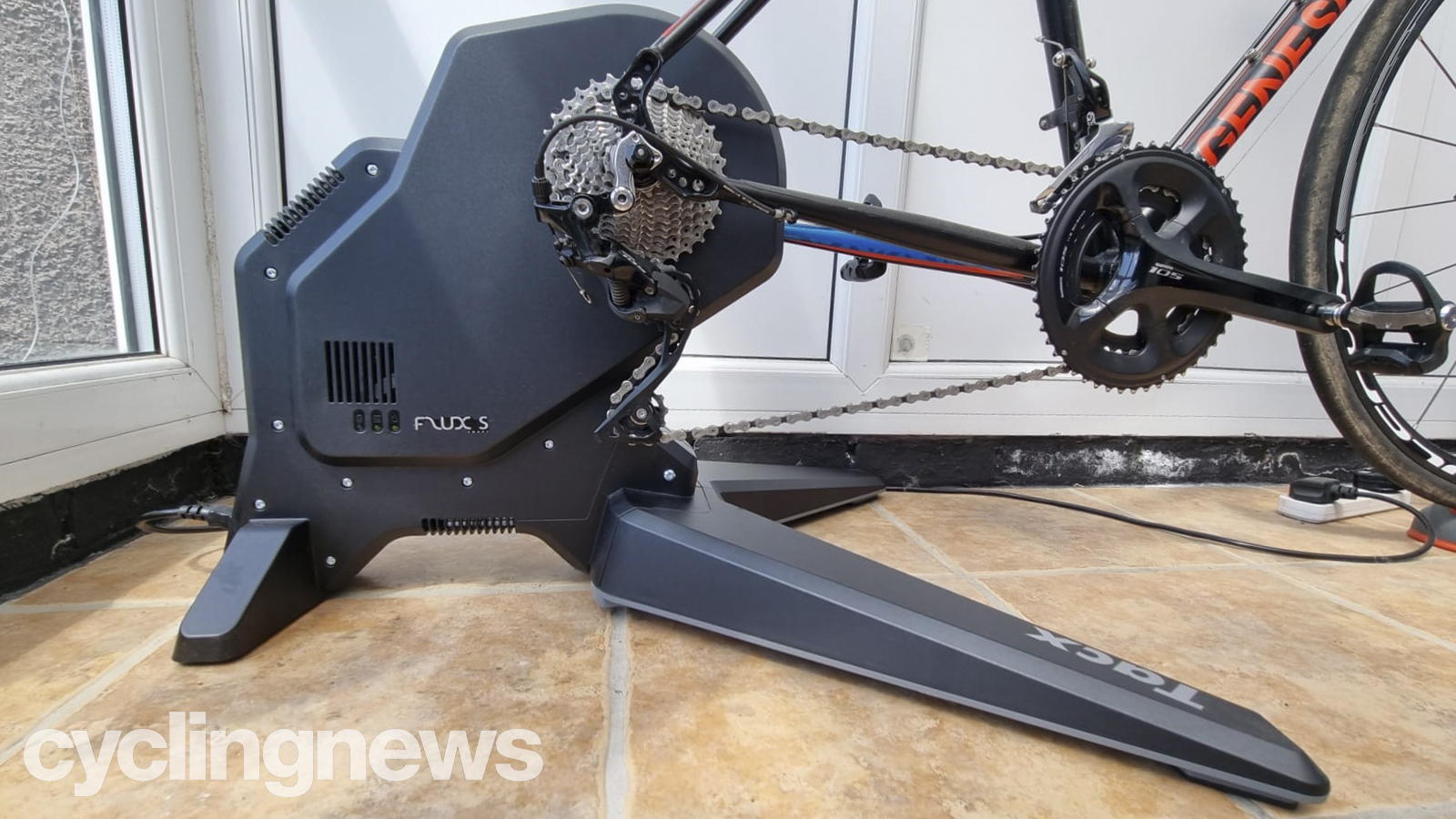
When you unpack the Tacx Flux S, the first thing you’ll notice is how heavy it is. It requires a little assembly but not much, and with very little effort. The unit is made up of two parts: the main body and the legs. In the box, alongside the trainer, you’re supplied with an 8mm Allen key, a quick-release axle, and a manual.
Not included is the cassette, so you'll need to supply your own, and you’ll also need to supply your own chain whip and lockring tool to attach it. The Flux S is immediately compatible with Shimano and SRAM cassettes from eight- to 11-speed, and you can buy a SRAM XDR driver or Campagnolo-compatible body separately. The supplied quick-release axle can work with both 142mm and 148mm widths, and there’s a 135x10mm adapter available for cyclocross and mountain bikes.
We recommend that you install the cassette prior to the legs, as it’s much easier to lay the main body sideways and slide the sprockets into place. From here it's easy to attach the legs and secure them.
The leg design is clever, forming a ‘V’ shape that provides lateral support. Once they’re attached, provided you’re on stable ground, they won’t budge at all, making the Flux S a sturdy and solid indoor trainer, albeit quite a hefty one at 20.9kg. It’s also quite large, measuring 67cm long, 46cm high and 64cm wide.
Once assembled, it’s time to put the Flux S into position, and that’s when you realise it has no carry handle, or really anything you can grip one hand around easily in order to move it from one place to another. Instead, it’s a full-body effort to lift the thing and plonk it down in a spot where it will probably stay until the end of time, because you’re not going through all that again any time soon. So choose its forever-home wisely.
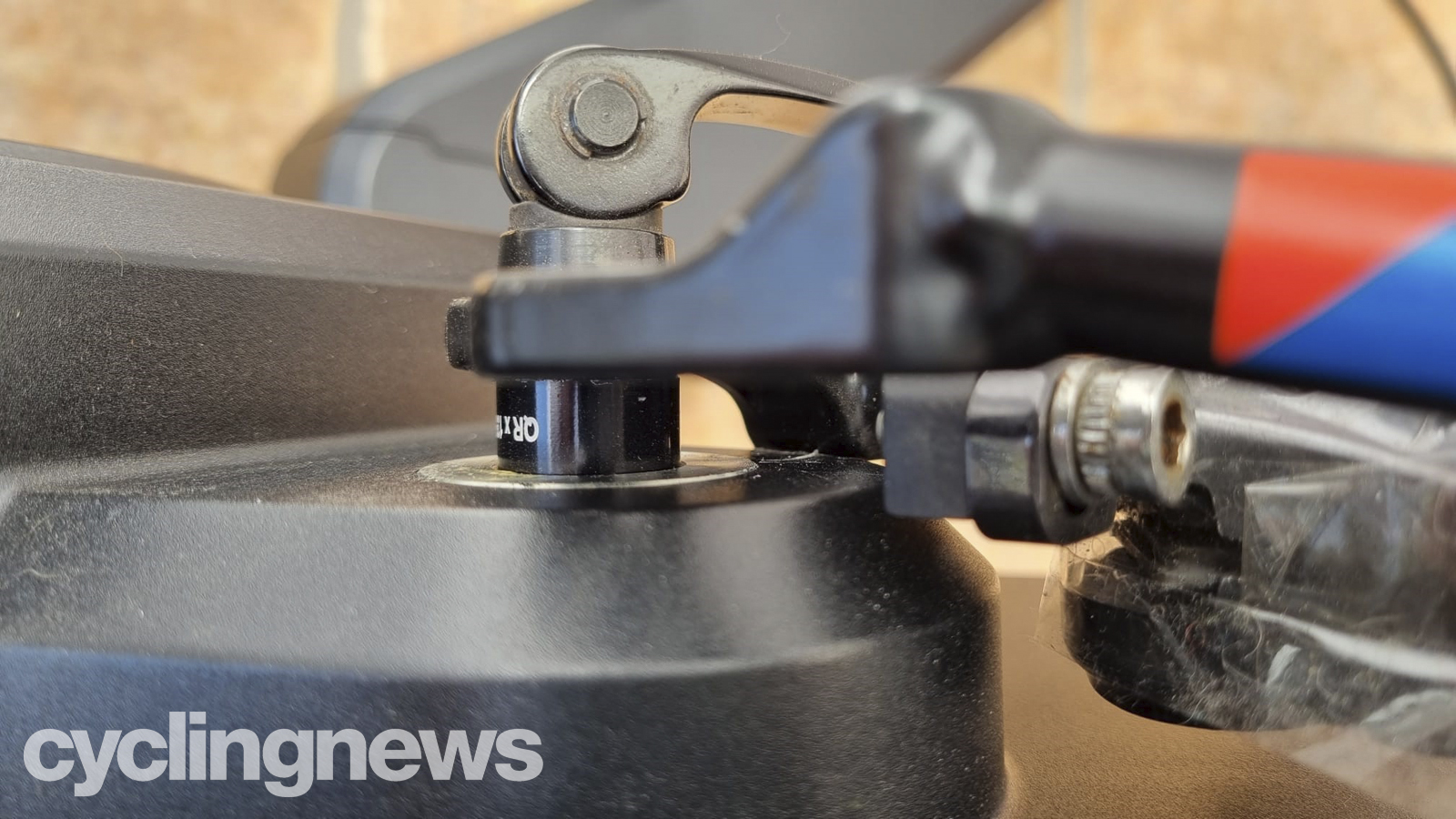
The Flux S is a direct-drive smart trainer, meaning you remove your rear wheel and mount the frame directly to the unit via the dropouts. Thanks to the supplied quick-release skewer and thru-axle adapter end caps, the unit is compatible with almost any road bike or mountain bike, including those with Boost rear spacing.
One minor hiccup I experienced almost immediately was that when I installed my circa-2017 road bike with post-mount disc brakes, I found there was actually about 1mm of overlap between the post mount adapter and the trainer. I was able to work around this, as it’s only a slight overlap, but it’s worth bearing in mind if you’re using an older bike.
Once your bike is installed, you’re pretty much ready to go. The startup is as simple as plugging it in and pedalling. As you’d expect from any smart trainer nowadays, the Flux S uses ANT+ and Bluetooth to connect to various devices, and I found it extremely quick and easy to connect with my Garmin Venu, Garmin Edge 830 and Zwift on my laptop — my cheapest Zwift setup. Being part of the Garmin family, the Tacx Flux S (and all of Tacx’s smart trainers, for that matter) connects seamlessly to the rest of the Garmin ecosystem. Once all these devices were hooked up, I added a Garmin Rally power meter to test for accuracy, and I was good to go.
Performance
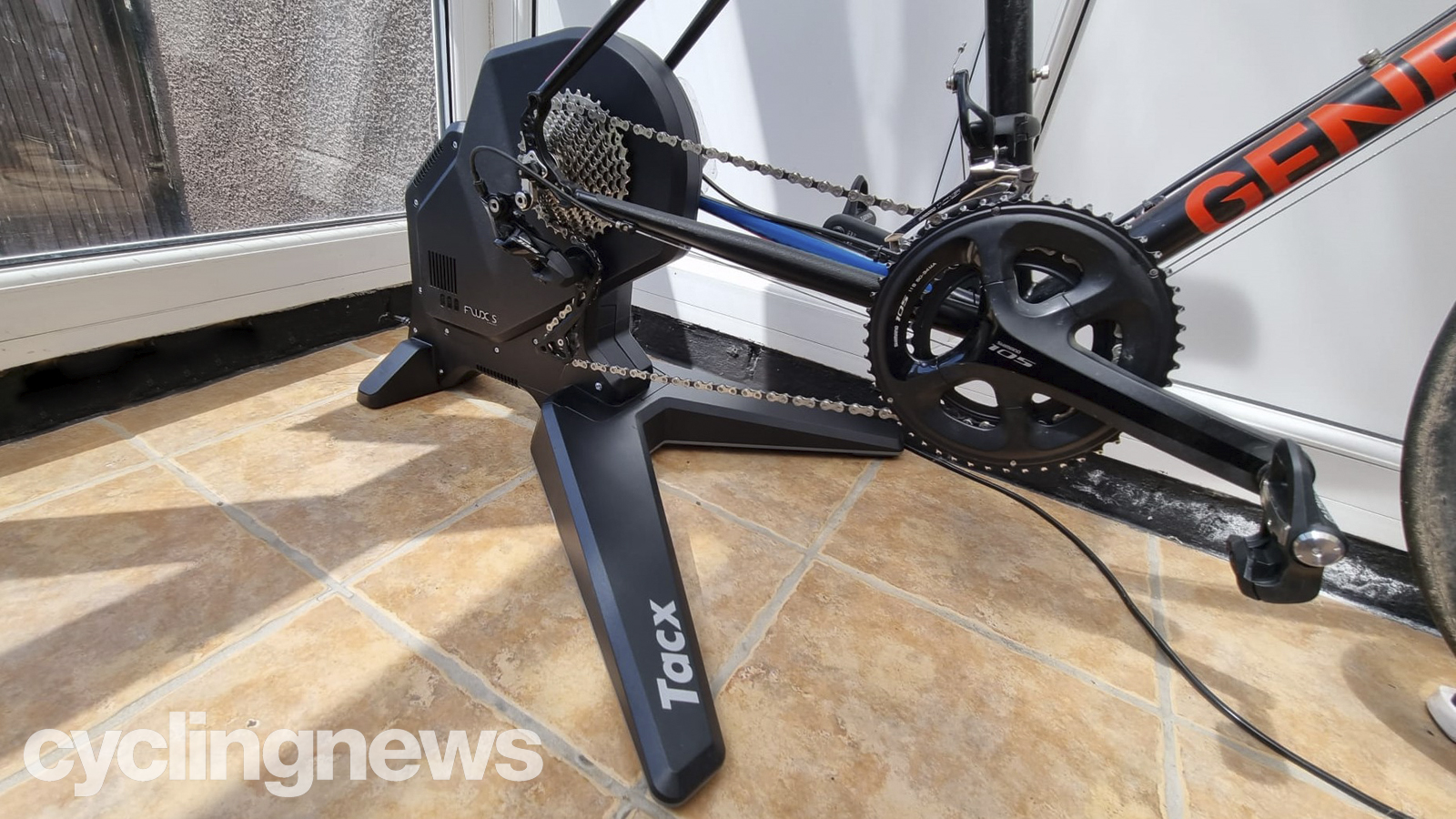
The Tacx Flux S is incredibly stable, thanks to its large footprint and hefty weight. It felt planted no matter how hard I worked out of the saddle, and those diagonally splayed legs do a wonderful job of preventing any side-to-side movement.
Despite being the brand’s most affordable direct-drive smart trainer, the Flux S has clearly benefited from some trickle-down technology from its more premium siblings. As I mentioned, it was easy to link up with Zwift, as well as the Tacx Training app, and from there barely any time had passed until I was pedalling through automatically changing gradients that realistically replicated the undulating terrain of the real world.
The Flux S uses eight permanent ferrite magnets and eight electromagnets to provide resistance, and it feels great. As the resistance increases and decreases throughout the ride, there are no sudden clunky movements; the transition is smooth and hardly noticeable until the gradient really kicks up or down. This is especially noticeable when climbing in Zwift.
Speaking of climbing, the Flux S can simulate gradients of up to 10 per cent. Compared to the 25 per cent capabilities of the Neo 2T, this may seem underwhelming to some, however when you consider that Zwift's Mont Ven-Top has an average gradient of 7.4 per cent, and the Alpe du Zwift 'Road to Sky' climb averages at 8.5 per cent, you can see that 10 is plenty for most people.
Its maximum resistance of 1,500 watts was also sufficient for my level of fitness. Of course, plenty of ‘pain cave’ devotees may be able to hit higher numbers, but only track sprinters will benefit from a trainer that is able to continually increase resistance beyond this point. In this case, the Flux 2 may be more sufficient, as it provides up to 2,000 watts of resistance and can simulate gradients of up to 16 per cent.
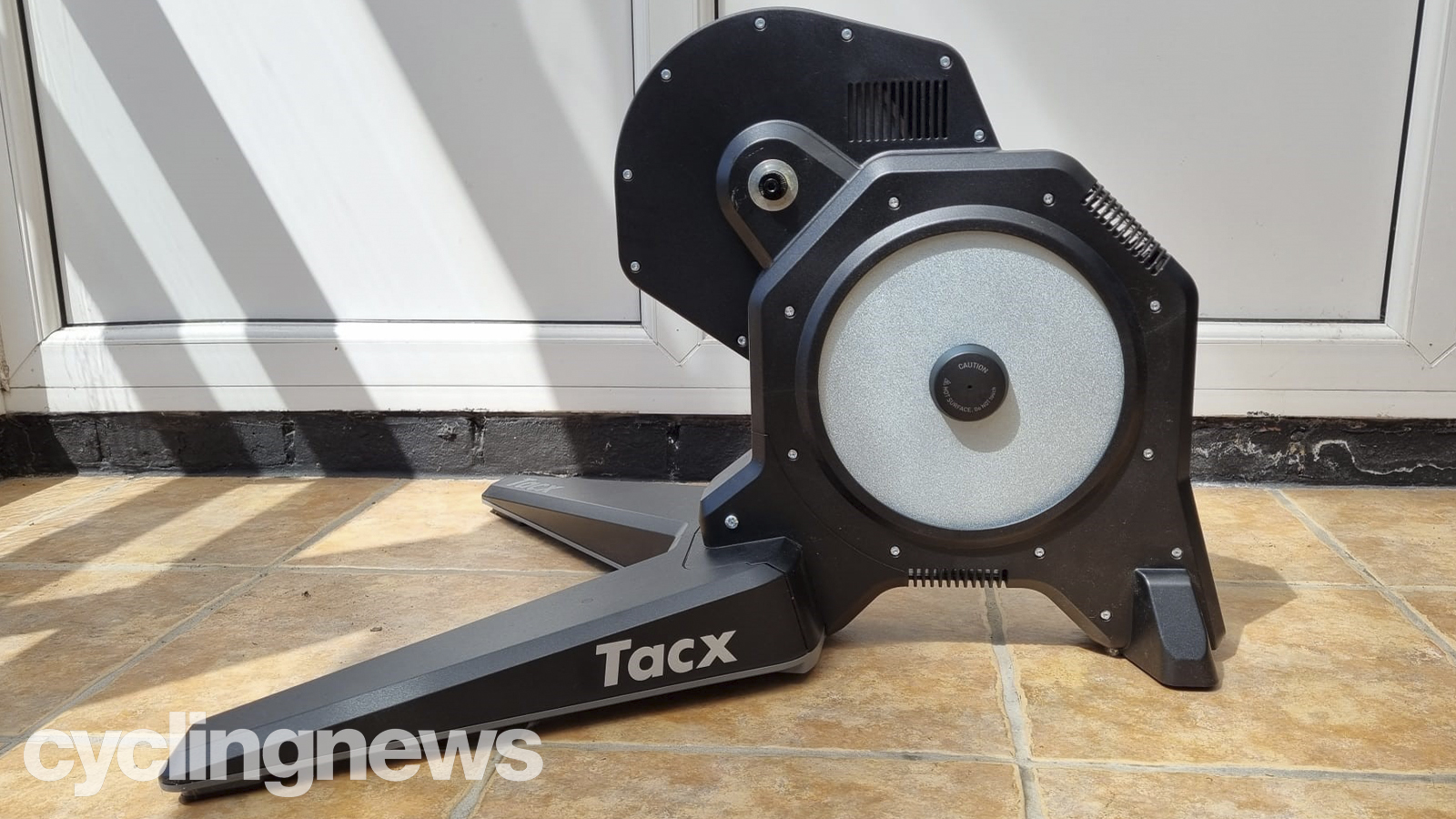
As I mentioned before, I paired the trainer with some Garmin Rally RK200 pedals to compare power readings, and while I'll save boring you with power comparison graphs, I come away certain that Tacx does indeed deliver on its claim to provide accuracy within -/+ three per cent. Of course, more expensive trainers will offer increased accuracy down to within one per cent, but for the average person, this is plenty sufficient to track your progress, provide reliable consistent training and get the most out of Zwift, or indeed any other virtual training platform.
For cadence data, the Flux S actually has a built-in sensor that cleverly uses an algorithm based on the maximum force you lay down while pedalling, which again results in some incredibly accurate readings.
The one concern comes in the responsiveness of the Flux S. In order to test how quickly it reacted to changes in resistance, I used the Tacx Training app to manually adjust the virtual gradient and clocked how quickly I felt that change through the pedals. There was a slight lag of around three seconds, which in itself is not a huge problem, but it could make all the difference if you’re taking part in a virtual race against folks riding atop more premium, and therefore more responsive, trainers.
The ride feel is excellent for what is essentially a budget-friendly direct-drive smart trainer. At 7kg, the flywheel is heavier than those of the Flux S’ competitors — 1.5kg heavier than the Wahoo Kickr Core, 2.8kg more than the Elito Direto X — which results in a superb and realistic ride-feel that doesn’t differ hugely from what you’d get on a trainer that costs twice the price.
It’s not as noisy as I was anticipating either, so it's safe to say, you shouldn’t be disturbing anyone else while you train, and if you’re anything like me, you’ll be able to enjoy the occasional episode of Gilmore Girls while building up a sweat.
Verdict
If you’re in the market for a direct-drive smart trainer you can be looking at spending at least a four-figure sum if you’re not careful, and while that might be the right choice for some, for many it can be overkill. The Tacx Flux S is a solid and stable trainer that’s versatile enough to be compatible with an array of bike types using different axle standards and freehub bodies, and it delivers excellent performance for a really competitive price.
It benefits from trickle-down technology from the brand’s more expensive models, and features plenty of interactive features thanks to its seamless connectivity with all the favourite virtual training apps. Plus, the ride-feel is truly impressive for the price.
Of course, we can’t fully forgive it for being so bulky and heavy, with no storage capability or carry handle, so it’s not ideal if you need something portable for small-apartment or race-day use. However, if you just want a dedicated space in your home for indoor training, then you’d be on to a winner here. Forget about sharing that part of the house with your family though, because the Flux S lives there now, it will probably die there, and long may it reign.
Tech specs: Tacx Flux S
- Price: £549 / $749.99 / AU$999
- Weight: 20.9kg
- Flywheel weight: 7kg
- Max power: 1,500w
- Max simulated grade: 10%
- Max torque: 22.1Nm
- Max brake force: 65Nm
- Accuracy: +/- 3%
- Connectivity: ANT+, ANT+ FE-C, and Bluetooth
- Freehub: Shimano/SRAM: 8-11 speed
- Axle compatibility: QR, 12x142, 12x148
- Dimensions: 67cm x 64cm x 46cm
Mildred joined as Reviews Writer for Cyclingnews and BikePerfect in December 2020. She loves all forms of cycling from long-distance audax to daily errand-running by bike, and does almost everything on two wheels, including moving house, and started out her cycling career working in a bike shop. For the past five years she's volunteered at The Bristol Bike Project as a mechanic and session coordinator, and now sits on its board of directors.
Since then she's gone on to write for a multitude of cycling publications, including Bikeradar, Cycling Plus, Singletrack, Red Bull, Cycling UK and Total Women's Cycling. She's dedicated to providing more coverage of women's specific cycling tech, elevating under-represented voices in the sport, and making cycling more accessible overall.
Height: 156cm (5'2")
Weight: 75kg
Rides: Stayer Groadinger UG, Triban RC520 Women's Disc, Genesis Flyer, Marin Larkspur, Cotic BFe 26, Clandestine custom bike
